
Algae is an informal term for a large and diverse group of photosynthetic eukaryotic organisms. It is a polyphyletic grouping that includes species from multiple distinct clades. Included organisms range from unicellular microalgae, such as Chlorella,Prototheca and the diatoms, to multicellular forms, such as the giant kelp, a large brown alga which may grow up to 50 metres (160 ft) in length. Most are aquatic and autotrophic and lack many of the distinct cell and tissue types, such as stomata, xylem and phloem that are found in land plants. The largest and most complex marine algae are called seaweeds, while the most complex freshwater forms are the Charophyta, a division of green algae which includes, for example, Spirogyra and stoneworts.

Brown algae, comprising the class Phaeophyceae, are a large group of multicellular algae, including many seaweeds located in colder waters within the Northern Hemisphere. Brown algae are the major seaweeds of the temperate and polar regions. They are dominant on rocky shores throughout cooler areas of the world. Most brown algae live in marine environments, where they play an important role both as food and as a potential habitat. For instance, Macrocystis, a kelp of the order Laminariales, may reach 60 m (200 ft) in length and forms prominent underwater kelp forests. Kelp forests like these contain a high level of biodiversity. Another example is Sargassum, which creates unique floating mats of seaweed in the tropical waters of the Sargasso Sea that serve as the habitats for many species. Many brown algae, such as members of the order Fucales, commonly grow along rocky seashores. Some members of the class, such as kelps, are used by humans as food.

Nereocystis is a monotypic genus of subtidal kelp containing the species Nereocystis luetkeana. Some English names include edible kelp, bull kelp, bullwhip kelp, ribbon kelp, bladder wrack, and variations of these names. Due to the English name, bull kelp can be confused with southern bull kelps, which are found in the Southern Hemisphere. Nereocystis luetkeana forms thick beds on subtidal rocks, and is an important part of kelp forests.
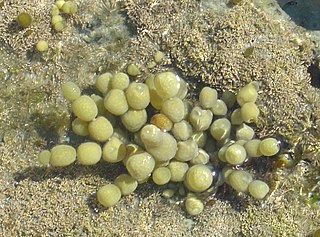
Hormosira banksii, also known as Neptune's necklace, Neptune's pearls, sea grapes, or bubbleweed) is a species of seaweed native to Australia and New Zealand. The genus Hormosira is monotypic.

Fucus is a genus of brown algae found in the intertidal zones of rocky seashores almost throughout the world.

Caulerpa is a genus of seaweeds in the family Caulerpaceae. They are unusual because they consist of only one cell with many nuclei, making them among the biggest single cells in the world. A species in the Mediterranean can have a stolon more than 3 metres (9.8 ft) long, with up to 200 fronds. This species can be invasive from time to time.
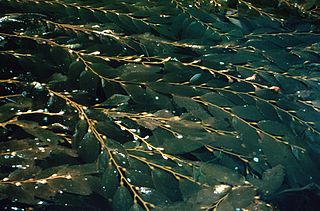
Macrocystis is a monospecific genus of kelp. This genus contains the largest of all the phaeophyceae or brown algae. Macrocystis has pneumatocysts at the base of its blades. Sporophytes are perennial and the individual may live for up to three years; stipes/fronds within a whole individual undergo senescence, where each frond may persist for approximately 100 days. The genus is found widely in subtropical, temperate, and sub-Antarctic oceans of the Southern Hemisphere and in the northeast Pacific from Baja California to Sitka, Alaska. Macrocystis is often a major component of temperate kelp forests.

Halimeda is a genus of green macroalgae. The algal body (thallus) is composed of calcified green segments. Calcium carbonate is deposited in its tissues, making it inedible to most herbivores. However one species, Halimeda tuna, was described as pleasant to eat with oil, vinegar, and salt.
Ascoseira is a monotypic genus of seaweed in the brown algae. The single and type species, Ascoseira mirabilis Skottsberg, is a large parenchymatous macroalgae, and is endemic to the Antarctic Ocean. Ascoseira is assigned to its own order. The alga grows in subtidal waters at depths of from 3 to 15 meters.

Monostroma is a genus of marine green algae (seaweed) in the family Monostromataceae. As the name suggests, algae of this genus are monostromatic. Monostroma kuroshiense, an algae of this genus, is commercially cultivated in East Asia and South America for the edible product "hitoegusa-nori" or "hirohano-hitoegusa nori", popular sushi wraps. Monostroma oligosaccharides with degree of polymerization 6 prepared by agarase digestion from Monostroma nitidum polysaccharides have been shown to be an effective prophylactic agent during in vitro and in vivo tests against Japanese encephalitis viral infection. The sulfated oligosaccharides from Monostroma seem to be promising candidates for further development as antiviral agents. The genus Monostroma is the most widely cultivated genus among green seaweeds.

Conceptacles are specialized cavities of marine and freshwater algae that contain the reproductive organs. They are situated in the receptacle and open by a small ostiole. Conceptacles are present in Corallinaceae, and Hildenbrandiales, as well as the brown Fucales. In the Fucales there is no haploid phase in the reproductive cycle and therefore no alternation of generations. The thallus is a sporophyte. The diploid plants produce male (antheridia) and female (oogonia) gametangia by meiosis. The gametes are released into the surrounding water; after fusion, the zygote settles and begins growth.

Seaweed, or macroalgae, refers to thousands of species of macroscopic, multicellular, marine algae. The term includes some types of Rhodophyta (red), Phaeophyta (brown) and Chlorophyta (green) macroalgae. Seaweed species such as kelps provide essential nursery habitat for fisheries and other marine species and thus protect food sources; other species, such as planktonic algae, play a vital role in capturing carbon, producing at least 50% of Earth's oxygen.
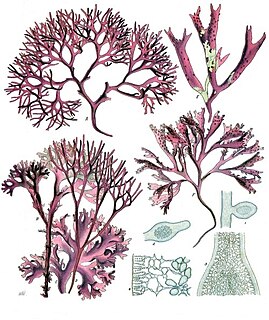
Red algae, or Rhodophyta, are one of the oldest groups of eukaryotic algae. The Rhodophyta also comprises one of the largest phyla of algae, containing over 7,000 currently recognized species with taxonomic revisions ongoing. The majority of species (6,793) are found in the Florideophyceae (class), and mostly consist of multicellular, marine algae, including many notable seaweeds. Red algae are abundant in marine habitats but relatively rare in freshwaters. Approximately 5% of red algae species occur in freshwater, environments with greater concentrations found in warmer areas. Except for two coastal cave dwelling species in the asexual class Cyanidiophyceae, there are no terrestrial species, which may be due to an evolutionary bottleneck in which the last common ancestor lost about 25% of its core genes and much of its evolutionary plasticity.

Macrocystis pyrifera, commonly known as giant kelp or bladder kelp, is a species of kelp, and one of four species in the genus Macrocystis. Despite its appearance, it is not a plant; it is a heterokont. Giant kelp is common along the coast of the northeastern Pacific Ocean, from Baja California north to southeast Alaska, and is also found in the southern oceans near South America, South Africa, Australia, and New Zealand. Individual algae may grow to more than 45 metres long at a rate of as much as 60 cm (2 ft) per day. Giant kelp grows in dense stands known as kelp forests, which are home to many marine animals that depend on the algae for food or shelter. The primary commercial product obtained from giant kelp is alginate, but humans also harvest this species on a limited basis for use directly as food, as it is rich in iodine, potassium, and other minerals. It can be used in cooking in many of the ways other sea vegetables are used, and particularly serves to add flavor to bean dishes.
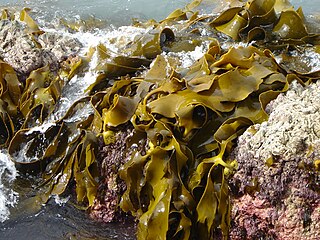
Phlorotannins are a type of tannins found in brown algae such as kelps and rockweeds or sargassacean species, and in a lower amount also in some red algae. Contrary to hydrolysable or condensed tannins, these compounds are oligomers of phloroglucinol (polyphloroglucinols). As they are called tannins, they have the ability to precipitate proteins. It has been noticed that some phlorotannins have the ability to oxidize and form covalent bonds with some proteins. In contrast, under similar experimental conditions three types of terrestrial tannins apparently did not form covalent complexes with proteins.
The epithallium or epithallus is the outer layer of a crustose coralline alga, which in some species is periodically shed to prevent organisms from attaching to and overgrowing the alga.

Ulva linza is a green alga in the family Ulvaceae that can be found in British Isles.

Analipus japonicus, or sea fir, is a brown alga species in the genus Analipus.
Zanardinia is a monotypic genus of seaweed in the brown algae. The only species, Zanardinia typus, commonly known as penny weed, is native to the northeastern Atlantic Ocean and the Mediterranean Sea.
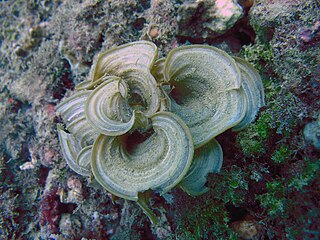
Padina is a genus of brown macroalgae in the family Dictyotaceae.


















